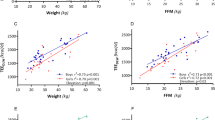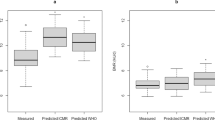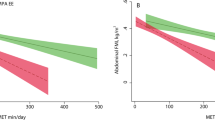Abstract
Objective:
To evaluate energy balance and physical activity in obese preschool children attending day-care centres.
Design:
Cross-sectional study.
Subjects:
Twenty-four 3–5 years old obese children selected at random from four different day-care centres in Santiago City, Chile. Total energy expenditure (TEE) was measured by doubly labelled water and physical activity as recorded by TRITRAC R3D motion sensor. Energy intake was assessed by measuring food intake while at the centre, along with the recording of additional food intake in the home.
Results:
Obese children had a 5.4% higher weighed energy intake than their energy requirements 2001. Energy intake during the week was 7716±1092 kJ/day and 7401±1023 kJ/day in boys and girls, respectively. Minimal activity was higher in the day-care centres (62%) compared to 52% during the weekend at home. Light activity was higher during the weekend at home than during the week (25 versus 20%), but moderate-intense activity was similar (3–5%).
Conclusions:
Reduction in dietary energy provided at the day-care centres helps to balance energy requirements during the week. Obese children had marked sedentary characteristics with regards to physical activity, although children are more active at home in weekends. This situation suggests that educators and parents need to improve children's physical activity levels and nutrition habits.
This is a preview of subscription content, access via your institution
Access options
Subscribe to this journal
Receive 12 print issues and online access
$259.00 per year
only $21.58 per issue
Buy this article
- Purchase on Springer Link
- Instant access to full article PDF
Prices may be subject to local taxes which are calculated during checkout

Similar content being viewed by others
References
Albala C, Vio F (1995). Epidemiological transition in Latin America, the case of Chile. Public Health 109, 431–442.
Alvina M, Araya H (2004). Rapid carbohydrate digestion rate produced lesser short-term satiety in obese preschool children. Eur J Clin Nutr 58, 637–642.
Barlow S, Dietz W (1998). Obesity evaluation and treatment, Expert Committee Recommendations. Pediatrics 102, 29.
Black AE, Prentice AM, Goldberg GR, Jebb SA, Bingham SA, Livingstone MB et al. (1993). Measurements of total energy expenditure provide insights into the validity of dietary measurements of energy intake. J Am Diet Assoc 93, 572–579.
Burrows R (2000). Childhood obesity prevention and treatment strategy to decrease the occurrence of non-communicable chronic diseases. Rev Med Chile 128, 105–110.
Butte NF, Ellis KJ (2003). Response to comment on ‘obesity and the environment: where do we go from here? Science 301, 598.
Cardona O (2001). Measurement of energy expenditure and pattern of physical activity in preschool children, attending the daycare centres (JUNJI). MSc. Thesis, Santiago, INTA, University of Chile, Santiago, Chile.
Coward WA (1990). Calculation of pool sizes and flux rates. In: Prentice AM (ed). The Doubly Labeled Water Method for Measuring Energy Expenditure: Technical Recommendations to Use in Humans. International Dietary Energy Consultancy Group: Vienna, pp 48.
Delany J (1998). Role of energy expenditure in the development of pediatric obesity. Am J Clin Nutr 68 (Suppl), S950–S955.
Department of Health of Chile, National Institute of Statistics (2000). The first national survey of quality of life and health. Santiago, Chile.
Elia M (1991). Energy equivalents of CO2 and their importance in assessing energy expenditure when using tracer techniques in assessing energy expenditure when using tracer techniques. Am J Physiol 35, 1169–1175.
Espinoza JF (1998). System of Index Food Monitoring Analysis of Changes in Food Habits. Institute of Nutrition and Food Technology (INTA), University of Chile: Chile. Technical Report..
FAO/WHO/UNU (1985). Energy and Protein Needs. FAO/WHO/UNU: Geneva, Switzerland. Technical Report Series 724.
FAO/WHO/UNU (2001). Human Energy Requirements. Report of a Joint FAO/WHO/UNU Expert Consultation.
Field A, Colditz G (1999). Overweight, central adiposity, and cardiovascular disease risk patterns in children. J Pediatr 135, 409–410.
Fomon S, Haschke F, Ziegler EE, Nelson SE (1982). Body composition of reference children from birth to age 10 years. Am Clin Nutr 35, 1169–1175.
Food and Nutrition Program, Technical Department (2002). National Board of Daycare Centres, Santiago, Chile.
Gidding S, Weihang B, Srivasan S, Berenson G (1995). Effects of secular trends in obesity on coronary risk factors in children, the Bogalusa Heart Study. J Pediatr 127, 868–874.
Global prevalence and secular trends in obesity (1997). Obesity Preventing and Managing the Global Epidemic. Report of a WHO Consultation on Obesity, Geneva, pp 17–39.
Government of Chile (2000). National Board of School Assistance and Scholarships (JUNAEB). Technical Agreement, Consultant Committee. Food Programs for School and Preschool Children, Santiago, Chile.
Hill RJ, Davies PS (2001). The validity of self-reported energy intake as determined using the doubly labelled water technique. Br J Nutr 85, 415–430.
Hill J, Wyatt H, Reed G, Peters J (2003). Obesity and the environment: where do we go from here? Science 299, 853–855.
Livingstone B, Coward WA, Prentice AM, Davies PSW, Strain J, McKenna P et al. (1992). Daily energy expenditure in free-living children, comparison of heart-rate monitoring with the doubly labeled water (2H18O) method. Am J Clin Nutr 56, 343–352.
Magarey AM, Daniels LA, Boulton TJ, Cockington RA (2002). Does fat intake predict adiposity in healthy children and adolescents aged 2–15 year? A longitudinal analysis. Eur J Clin Nutr 56, 1046–1047.
Maillard G, Charles MA, Lafay L, Thibult N, Vray M, Borys JM et al. (2000). Macronutrient energy intake and adiposity in non obese prepubertal children aged 5–11 year (the Fleurbaix Laventie Ville Sante Study). Obes Relat Metab Disord 12, 1608–1617.
Matheson DM, Killen JD, Wang Y, Varady A, Robinson TN (2004). Children's food consumption during television viewing. Am J Clin Nutr 79, 1088–1094.
O’Connor J, Ball EJ, Steinbeck KS, Davies PS, Wishart C, Gaskin KJ et al. (2001). Comparison of total energy expenditure and energy intake in children aged 6–9 years. Am J Clin Nutr 74, 643–649.
Overby NC, Lillegaard IT, Johansson L, Andersen LF (2004). High intake of added sugar among Norwegian children and adolescents. Public Health Nutr 7, 285–293.
Pellegrini AD, Smith PK (1998). Physical activity play, the nature and function of a neglected aspect of playing. Child Dev 69, 577–598.
Reilly JJ, Jackson DM, Montgomery C, Kelly LA, Slater C, Grant S et al. (2004). Total energy expenditure and physical activity in young Scottish children: mixed longitudinal study. Lancet 363, 211–212.
Rennie KL, Jebb SA, Wright A, Coward WA (2005). Secular trends in under-reporting in young people. Br J Nut 93, 241–247.
Reston VA (2002). Active start – a statement of physical activity guidelines for children birth to five years. American Alliance for Health, Physical Education, Recreation and Dance. National Association for Sport and Physical Education (NASPE), 2002.
Rojas J, Uauy R (1999). Need to prevent obesity without abandoning the protection of children in risk of malnourishment. Rev Chil Nutr 26, 35–39.
Rolland-Cachera MF, Deheeger M, Guilloud-Bataille M, Avons P, Patois E, Sempe M (1987). Tracking the development of adiposity from one month of age to adulthood. Ann Hum Biol 14, 219–229.
Rowlands AV, Eston RG, Ingledew DK (1999). Relationship between activity levels, aerobic fitness, and body fat in 8- to 10-yr-old children. J Appl Physiol 86, 1428–1435.
Rowlands AV, Thomas PW, Eston RG, Topping R (2004). Validation of the RT3 triaxial accelerometer for the assessment of physical activity. Med Sci Sports Exerc 36, 518–524.
Schmidt-Hebbel H, Pennacchiotti I, Masson L, Mella MA (1992). Table of chemical composition of Chilean food. Faculty of Chemical and Pharmaceutical Sciences, Department of Sciences of the Food and Chemical Technology, University of Chile, Santiago of Chile.
Schoeller AD (1996). Hydrometry. In: Roche A, Heymsfield S and Lohman T (eds). Human Body Composition. Human Kinetics: Champaign, Ill, pp 25–43.
Schofield WN (1985). Predicting basal metabolic rate, new standards and review of previous work. Hum Nutr Clin Nutr 39C (Suppl.1), S5–S41.
Stock M (1999). Gluttony and thermogenesis revisited. Int J Obes Relat Metab Disord 23, 1105–1117.
Tojo R, Leis R, Castro J, Pombo M (1999). Causes and consequences of excess in the pediatric age. Rev Chil Nutr 26, 175–184.
Trost SG, Sirad JR, Dowda M, Pfeiffer KA, Pate RR (2003). Physical activity in overweight and non-overweight preschool children. Int J Obes Relat Metab Disord 27, 834–839.
Tverskaya R, Rising R, Brown D, Lifshitz F (1998). Comparison of several equations and derivation of a new equation for calculating basal metabolic rate in obese Children. J Am Coll Nutr 17, 333–336.
Vera G, Alvina M, Rojas J, Delgadillo A, Duran R, Fajardin N et al. (1991). Feeding structure, nutritional value and acceptability of preparations included in the institutional feeding of preschool children. Free Communications. Rev Chil Nutr 19, 39–56.
Vio F, Albala C (2000). Obesity epidemiology. Rev Chil Nutr 27 (Suppl. 1), S97–S104.
Welk GJ, Corbin CB (1995). The validity of the Tritrac-R3D Activity Monitor for the assessment of physical activity in children. Res Q Exerc Sport 66, 202.
Westertep KR (1999). Physical activity assessment with accelerometers. Int J Obes Relat Metab Disord 23 (Suppl 3), S45–S49.
WHO (World Health Organization Working Group (1986). Use and interpretation of anthropometric indicators of nutritional status. Bull World Health Organ 64, 929–941.
Author information
Authors and Affiliations
Corresponding author
Additional information
Guarantor: G Salazar.
Contributors: FV contributed to project design, field study, data analysis and paper draft; GS to conception and design of the study, supervision of data collection and analysis, paper draft and final revision; MA to dietary intake methodology and data analysis; LV to doubly labelled water measurement by IRMS and participated in paper draft and ED to discussion of results and revision of paper draft.
Rights and permissions
About this article
Cite this article
Vásquez, F., Salazar, G., Andrade, M. et al. Energy balance and physical activity in obese children attending day-care centres. Eur J Clin Nutr 60, 1115–1121 (2006). https://doi.org/10.1038/sj.ejcn.1602426
Received:
Revised:
Accepted:
Published:
Issue Date:
DOI: https://doi.org/10.1038/sj.ejcn.1602426
Keywords
This article is cited by
-
The validity of dietary assessment methods to accurately measure energy intake in children and adolescents who are overweight or obese: a systematic review
European Journal of Clinical Nutrition (2018)
-
Multifactorial Influences of Childhood Obesity
Current Obesity Reports (2013)
-
Physical activity and fat mass gain in Mexican school-age children: a cohort study
BMC Pediatrics (2012)
-
Plasma Zinc Concentration, Body Composition and Physical Activity in Obese Preschool Children
Biological Trace Element Research (2007)



